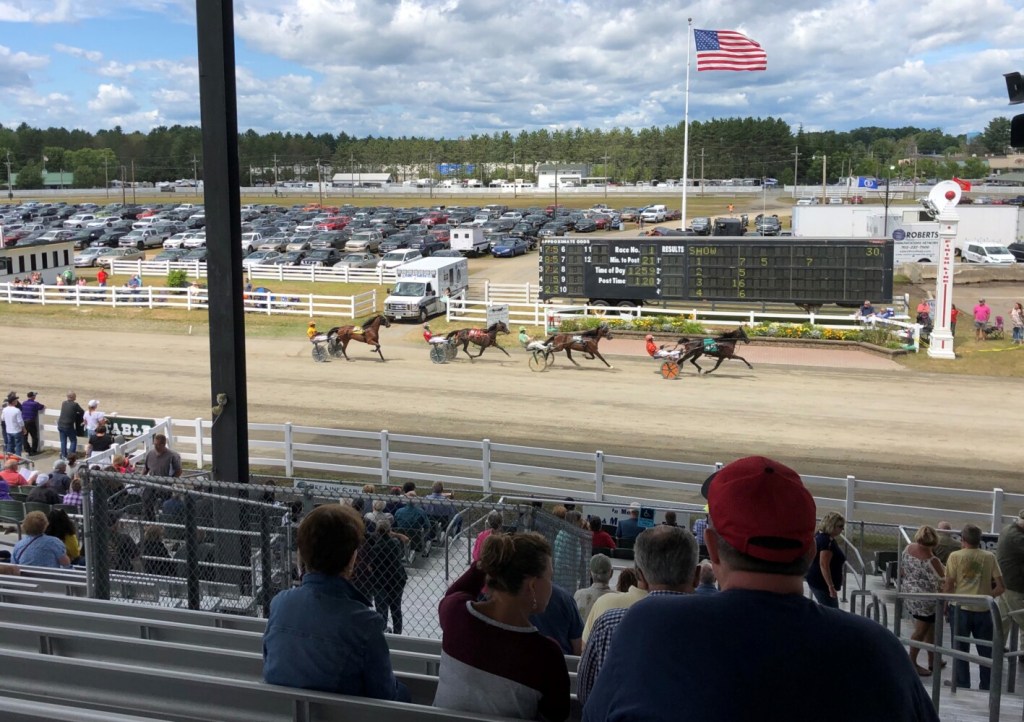SKOWHEGAN — The sound of a bugle call rang through the Skowhegan Fairgrounds just after 1 p.m. Sunday, commencing the first of seven days of harness racing at the annual summer fair.
The horse races in Skowhegan are among eight that take place at fairgrounds in Maine annually, according to Pari-Mutuel Director Terry Rice, who watched as clusters of people lay wagers beneath the grandstand.
“Fryeburg is the biggest, obviously, then Windsor, and then Skowhegan follows closely in there,” Rice said. The state is also home to two commercial horse racing ventures in Bangor and Scarborough.
In pari-mutuel style betting, which is the norm for harness racing, the overall pool is divided among the winners after taxes have been deducted from the pot. Last year, Rice noted, the initial figure in Skowhegan reached over $179,000. If the Topsham Fair is any indicator, earnings could be higher this year. Betting was up a total of $11,000 from 2018 at the Topsham Fair, which wrapped up its harness racing Saturday.
The cornerstone racing event in Skowhegan this year — the Walter H. Hight Memorial Pace — will take place Saturday at 1 p.m.
Those watching the races Sunday ranged from longtime Skowhegan State Fair-goers to first-timers. This is the 201st year of the event.
Dennis Bess, 72, of Madison, said he has come to the fair with family members for about 30 years and has had some luck wagering on the horses in the past.
“We like to watch the horses run and we bet a little, but we’re not addicted or anything,” he joked after one of the afternoon’s nonbetting events. There were 13 races in total Sunday, each one mile long and distinguished by gait style — pace or trot — and the horses’ ability, or trackmaster rating. The nonbetting events feature the youngest of the horses — the colts and fillies.
According to the United States Trotting Association, a horse’s tendency to trot or pace is genetic, but the ability to maintain either gait at at high speeds and over long distances takes years of training.
“Pacers move both legs on the same side forward in unison,” the association notes, while “trotters move left front and right rear legs forward almost simultaneously, then follow suit with right front and left rear.” Pacers tend to be faster. But, as seasoned viewer and former horse-driver Debbie Farrington noted, trotting is more challenging.
Farrington, 59, of Richwood, Ohio, was in Skowhegan for the first time Sunday, in the midst of a cross-country trip with her husband, Larry, 69.
“I used to drive (trotters) in the late ’70s, early ’80s,” Debbie Farrington said. “When my brother and I were growing up, (my grandpa) always made sure we had a horse, and so we each had a horse to take care of and drive, and that’s what we did.”
Larry Farrington raced too, before he was in a wreck and decided not to drive horses anymore. His uncle, Bob Farrington, trained and drove United States Harness Racing Hall-of-Famer Rambling Willie, one of the first horses to make over $1 million. Another uncle, Dick Farrington, trained and drove two other racing horses, Laag and Storm Damage.
While it’s safer in the grandstand, Debbie Farrington said that she can’t help but feel a tinge of nostalgia for her racing days.
“I like both,” she said before flashing a smile. “Watching is OK, but I’d rather have a horse to race. It’s a rush.”
Copy the Story LinkSend questions/comments to the editors.



Success. Please wait for the page to reload. If the page does not reload within 5 seconds, please refresh the page.
Enter your email and password to access comments.
Hi, to comment on stories you must . This profile is in addition to your subscription and website login.
Already have a commenting profile? .
Invalid username/password.
Please check your email to confirm and complete your registration.
Only subscribers are eligible to post comments. Please subscribe or login first for digital access. Here’s why.
Use the form below to reset your password. When you've submitted your account email, we will send an email with a reset code.